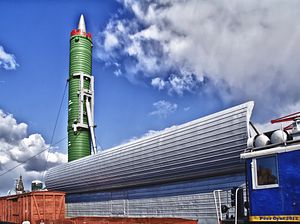On December 5, China conducted a launcher test of a new rail-mobile version of its newest intercontinental ballistic missile (ICBM), the DF-41 (CSS-X-20), IHS Jane’s Defence Weekly reports.
A DF-41 also underwent a flight test on the previous day (December 4) the publication states based on information obtained by the Washington Free Beacon. The launch of the DF-41 likely took place at the Wuzhai missile test center in central China’s Shanxi Province.
The December 5 test involved a ‘cold launch’ of a DF-41 from a canister with a gas charge without the engine of the missile being ignited. In a full test, the missile’s engine would ignite microseconds after exiting the launch tube.
China’s Defense Ministry confirmed at the end of December that the tests took place without going into details. “Scientific tests within the Chinese territory are conducted according to plan,” Defense Ministry spokesman Colonel Yang Yujun said at a press conference.
According to IHS Jane’s Defense Weekly, the launch “was likely meant to test the tube launch system’s compatibility with its new rail car.” The Washington Free Beacon notes a 2013 study compiled by the Georgetown University Arms Control Project which argues that the Chinese rail-mobile ICBM system is modeled on the Ukrainian-designed RT-23 (SS-24 ‘Scalpel’) rail-mobile solid-fuel ICBM.
The RT-23 is “known as a ‘land nuclear submarine’—an indication the rail launcher uses an ejection tube to boost the missile from the train car shortly before ignition of its engine,” according to the article. The RT-23 was deployed by Moscow from 1987 to 2005. Russia is currently working on another rail-mobile ICBM system slated to enter service by 2020.
Chinese missiles aboard trains will be particularly difficult to track for U.S. intelligence agencies.
“If that missile train hosts the DF-41 ICBM it means it will also have a MIRV [multiple, independently-targetable reentry vehicles] potential,” defense analyst Phillip A. Karber told the Washington Free Beacon. “The combination of high-speed mobility, launch cars disguised as civilian passenger trains, tunnel protection and secure reloading of missiles, coupled with multiple warheads, makes the system extremely hard to regulate or verify the number of systems.”
“Since then there have been reports that China’s 2nd Artillery Corps, the force that operates the missiles, had built 2,000 kilometers [1,243 miles] of heavy gauge rail for this system,” Karber added. By 2050, China could have more than 273,500 kilometers (170,000 miles) of train tracks.
As I reported before (See: “China Tests New Missile Capable of Hitting Entire United States”):
U.S. intelligence agencies estimate that the DF-41 can carry up to ten 150-300 kiloton yield thermonuclear warheads per missile and that it is capable of targeting the entire continental United States. It is solid fueled, road mobile and has an estimated range of between 12,000 and 15,000 km (6,835 miles and 7,456 miles).
The missile will likely be deployed sometime between 2018 and 2020 and could be armed with a DF-ZF (previously known as WU-14) hypersonic glide vehicle (HGV).
































